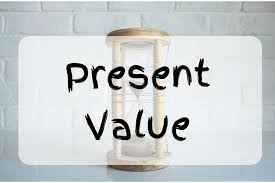
PV is the present worth of an upcoming quantity of cash or a stream of cash flows at a specific yield. The future cash flow is discounted using the discount rate, and the greater the discount rate, the lower the present value of the cash flows. Deciding on the right discount rate is crucial to accurately value future cash flows, regardless of whether they're dividends or debt commitments.
Understanding PV
Present value is the notion that a certain amount of money today is worth more than the same amount in the near future. Also, the money received in the near future will not be equivalent to the amount you receive today. The present value of $1,000 is greater than $1000 five years later. Why? Investors can invest $1,000 today and likely get a return in the coming five years. The value of the present takes into consideration the interest rate that the investment could earn.
For example, when an investor is offered $1,000 today and can earn an annual rate of 5 percent return per year, the $1000 today is worth more than the $1,000 five years down the road. If an investor had waited five years for the $1,000, then there is an opportunity cost, or the investor would miss out on the return rate over the five years.
Discount Rate for Finding Present Value
A discount rate is the rate of return calculated using present values calculations. Also, the discount rate will be the rate at which an investor would lose a return if an investor chooses to accept a certain amount in the future versus the identical amount now. The discount rate used in calculations of the current value is extremely dependent on the rate of return you'd get when you invested in today's dollars for a set period.
In many instances, it is the case that a risk-free rate return is calculated and then utilized for the rate of discount, also known as the hurdle rate. The rate is the return the project or investment needs to earn to be worthy of pursuing. The U.S. Treasury bond rate is frequently used as risk-free since the U.S. government guarantees Treasuries. For instance, an investment of two years Treasury offered a 2% rate of interest or yield; the investment needs at a minimum to earn at least 2% to justify the risks.
Discount rates are the product of time values and an interest rate that mathematically boosts the value of future events in absolute or nominal terms. The discount rate is utilized to determine the value of future events in relation to the actual value, allowing the lender to settle the fair value of future liabilities or earnings concerning the present capital amount. The term "discount" refers to future value being discounted in relation to the current value.

The calculation of present or discounted value is vital in various financial calculations. For instance, the net present value calculation, bond yields, and pension obligations depend on present or discounted value. Knowing how to utilize a financial calculator to calculate present value can aid you in deciding whether you should take advantage of such offers for cash-back or 0% financing on buying a vehicle or paying off points for a mortgage.
Present Value vs. Future Value
The comparison of the present value and the future value best illustrates the value of money over time and the necessity for charging or paying extra risks-based interest rates. Simply put, cash today is more valuable than future value due to the passing of time. The future value may refer to future cash flow through the investment of today's cash or the future installment needed to repay the loan today.
The future value represents the amount of an asset in its current state at a specific date in the near future based on an assumed growth rate. The equation for FV takes a fixed growth rate and an upfront payment of one amount left in a state of nil throughout the life of an investment. The FV equation allows investors to forecast the amount of profit generated from different investment strategies with various degrees of precision.

Present value is the present value of a potential sum of cash or flows at a certain yield. Present value considers the value of the future and then applies an interest rate, or discount rate, to the rate of interest that can be earned by investing. Future value tells you how much an investment will be worth. The present value indicates how much you'll need today in dollars to earn a particular amount in the near future.



